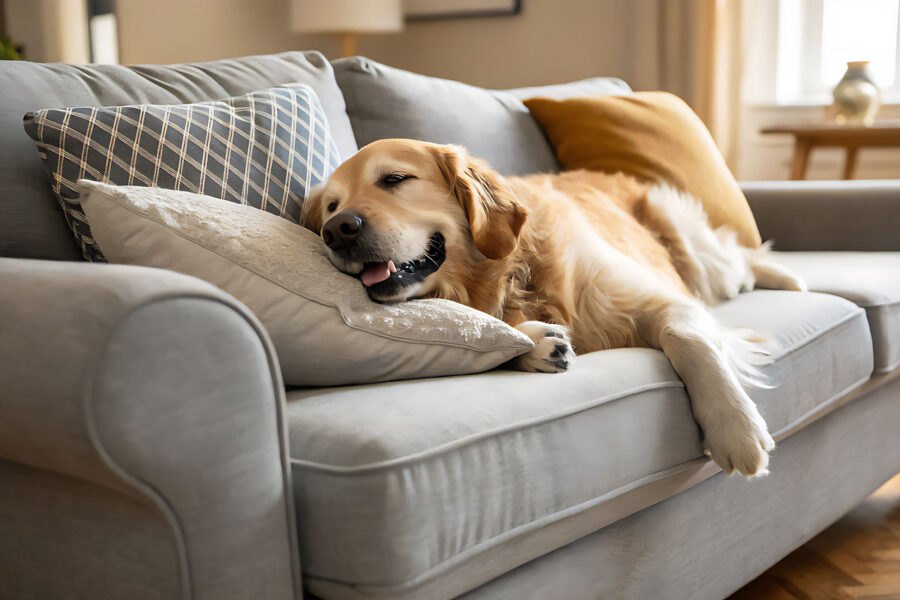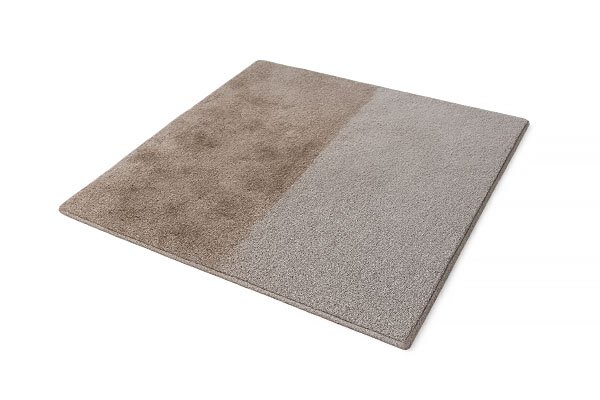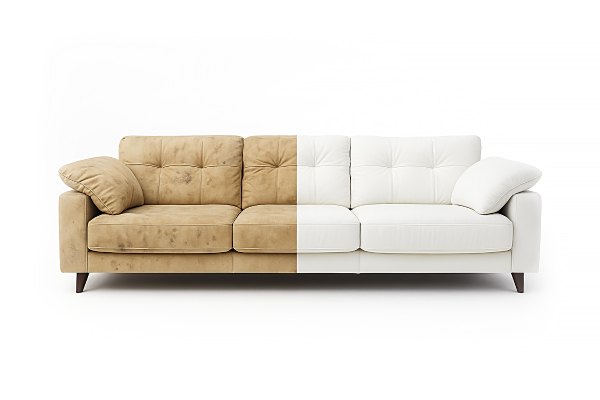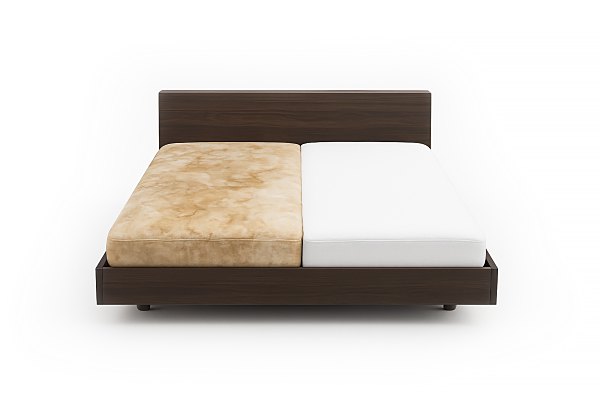Living with pets brings joy and companionship, but also the constant battle against fur on furniture. Pet hair sticks to upholstery due to static electricity and the fabric’s texture, making removal challenging. Various methods exist to tackle this common problem, from simple household items to specialized tools.
The type of upholstery fabric affects how easily pet hair can be removed. Tightly woven fabrics like microfiber tend to trap less hair than looser weaves or textured materials. Light-colored furniture shows pet hair more than darker colors, while leather and vinyl surfaces allow easier hair removal than fabric upholstery.
Regular cleaning prevents buildup that becomes harder to remove over time. Quick daily maintenance reduces the need for deep cleaning sessions. The right tools make a big difference – rubber gloves, lint rollers, vacuum attachments, and even dampened sponges can all be effective depending on the situation.
For those with allergies, removing pet hair isn’t just about aesthetics but health. Pet dander attached to hair can trigger allergic reactions. Proper cleaning techniques help maintain both furniture appearance and indoor air quality.
This guide covers practical methods for removing pet hair from upholstered furniture, from quick fixes to thorough cleaning approaches. These techniques work for various furniture types and pet hair situations, helping keep homes clean and comfortable for both humans and pets.
The rubber glove method that makes pet hair removal a breeze
The rubber glove method stands out as one of the simplest yet most effective ways to remove pet hair from upholstered furniture. This technique uses basic household rubber gloves to lift fur through static electricity and friction.
How it works
Rubber creates static electricity when rubbed against fabric. This static charge attracts and lifts pet hair from upholstery fibers. The slightly textured surface of rubber gloves also helps grab hair that’s embedded deeper in the fabric.
To use this method, put on a pair of rubber dishwashing gloves and run hands over the furniture surface. The hair will start to clump together, making it easy to gather and dispose of. For better results, slightly dampen the gloves with water. The moisture helps increase friction and makes the hair stick to the gloves more effectively.
Work in one direction using short, deliberate strokes. Start from the top of furniture pieces and move downward to avoid spreading the hair. Focus on small sections at a time for thorough cleaning.
The same static electricity principle that makes pet hair stick to furniture is what makes this rubber glove method so effective at removing it.
Tips for maximum effectiveness
Textured gloves work best. Gloves with small bumps or ridges on the palm and fingers grip hair more effectively than smooth ones. These textured surfaces create more friction, making it easier to dislodge stubborn hair.
Rinse gloves regularly during cleaning. As hair builds up on the gloves, rinse them in water. The hair will float to the top, allowing easy removal. Shake off excess water before continuing.
For heavily shedding pets, this method might need to be repeated several times. The rubber glove technique works well for spot cleaning between more thorough cleaning sessions. It’s perfect for quick touch-ups before guests arrive.
This method works on most upholstery types but is particularly effective on:
- Microfiber couches
- Fabric armchairs
- Cushion covers
- Car upholstery
The rubber glove approach costs nothing if gloves are already available at home. It’s chemical-free and gentle on fabrics, making it safe for all furniture types.
Why your vacuum attachments are the secret weapon against stubborn fur
Vacuum cleaners with the right attachments transform pet hair removal from a frustrating chore to a quick task. The key lies in using specialized attachments designed specifically for upholstery and pet hair.
Choosing the right attachments
Not all vacuum attachments work equally well for pet hair. The most effective ones include:
- Upholstery tool – This flat, wide attachment with a brush surface lifts hair from fabric while the vacuum suction pulls it away. The brush agitates the fabric just enough to loosen embedded hair without damaging the material.
- Pet hair brush – Specialized for fur removal, these attachments often feature rubber bristles that create static electricity to attract hair. The rubber bristles grab hair that regular vacuum heads might miss.
- Crevice tool – Perfect for reaching hair trapped in seams, corners, and tight spaces between cushions. These narrow attachments direct strong suction to small areas where pet hair tends to accumulate.
- Motorized brush roll – Some vacuums offer powered brush attachments that actively rotate to pull hair from upholstery fibers. These work well for deeply embedded fur on heavily used furniture.
Vacuum attachments can make a big difference when dealing with pet hair. Flat upholstery tools are handy for general cleaning. Pet hair brushes with rubber bristles grab fur better than regular heads. Use crevice tools to get into corners and seams. Motorised brushes help lift hair stuck deep in the fabric. Each tool does a job, so mix and match depending on where the fur is hiding.
Effective vacuuming techniques
The way the vacuum is used matters as much as the attachment chosen. For best results.
Move the vacuum in multiple directions over the same area. Hair gets trapped in fabric from different angles, so changing direction helps catch more of it. Start with horizontal strokes, then switch to vertical.
Use slow, deliberate movements rather than quick passes. This gives the vacuum time to create suction and pull hair from deeper in the fabric. Fast movements might only remove surface hair.
Work in sections to ensure thorough cleaning. Divide larger furniture pieces into manageable areas and complete each before moving on.
Empty the vacuum canister or change the bag regularly during cleaning. A full vacuum loses suction power, making it less effective at removing pet hair.
Interesting fact: Vacuuming upholstery not only removes visible pet hair but also captures microscopic dander particles that can trigger allergies.
For stubborn areas, lightly mist the upholstery with water before vacuuming. This helps clump the hair together, making it easier for the vacuum to pick up. Be careful not to saturate the fabric.
Pre-treatment with a fabric softener solution (one tablespoon of fabric softener mixed with water in a spray bottle) helps neutralize static that makes hair cling to upholstery. Spray lightly, let sit for a few minutes, then vacuum.
Book professionals to clean upholstered furniture
Sometimes, the best solution for pet hair removal is calling in professional cleaners. Professional upholstery cleaning services have specialized equipment and techniques that go beyond what’s possible with household methods.
When to call the professionals
Professional cleaning becomes necessary when:
- Pet hair has built up over time and home methods aren’t making much difference. Deeply embedded hair mixed with oils from pet skin can be difficult to remove without professional equipment.
- Furniture needs a thorough cleaning beyond just hair removal. Professional services address stains, odors, and allergens along with pet hair.
- Valuable or antique furniture requires careful handling. Professionals know how to clean different upholstery materials without causing damage.
SevenClean in Sydney offers comprehensive upholstery cleaning services that address pet hair problems along with deep cleaning. Their technicians use specialized equipment that extracts hair from deep within furniture fibers.
Professional cleaning services by SevenClean
SevenClean’s upholstery cleaning service uses hot water extraction methods that flush out pet hair along with dirt and allergens. This process is more thorough than what’s possible with household vacuums.
Their technicians first inspect the furniture to identify the fabric type and appropriate cleaning method. They then pre-treat areas with heavy pet hair accumulation using special solutions that help loosen the hair from the fibers.
The cleaning process involves several steps:
- Thorough vacuuming with commercial-grade equipment
- Application of pet-safe cleaning solutions
- Hot water extraction that pulls hair and dirt from deep in the fabric
- Careful drying to prevent mold or mildew
SevenClean also offers mattress cleaning services that remove pet hair and dander from beds. This service is particularly valuable for pet owners who allow animals on their beds. The process sanitizes mattresses while removing allergens that can affect sleep quality.
For homes with carpets and rugs that also collect pet hair, SevenClean provides carpet and rug cleaning services. Their comprehensive approach ensures all soft surfaces in the home are free from pet hair and dander.
Professional upholstery cleaning not only removes visible pet hair but can extract up to 98% of allergens trapped in furniture, significantly improving indoor air quality.
Regular professional cleaning helps extend furniture life by removing oils and particles that break down fabric over time. For pet owners, scheduling professional cleaning once or twice yearly provides a fresh start that makes daily maintenance easier.
SevenClean services
Simple household items that tackle pet hair better than expensive gadgets
Many effective pet hair removal tools are already available in most homes. These everyday items often work better than specialized products marketed specifically for pet hair.
Kitchen supplies that double as fur fighters
Damp sponge – Slightly wet a clean sponge and wipe it across upholstery in long, firm strokes. The moisture helps gather hair into clumps that can be picked up by hand. This method works well on delicate fabrics that might be damaged by more aggressive approaches.
Squeegee – Window squeegees with rubber edges excel at pulling pet hair from upholstery. The rubber edge creates friction that lifts hair from fabric fibers. Run the squeegee across furniture surfaces in short, firm strokes to collect hair into lines that can be gathered by hand or vacuumed.
Fabric softener spray – Mix one part fabric softener with three parts water in a spray bottle. Lightly mist upholstery and let sit for a few minutes before wiping with a cloth or vacuuming. The fabric softener reduces static electricity that makes hair cling to furniture.
Unexpected household helpers
Dryer sheets – Rub a dryer sheet across upholstery to reduce static and collect hair. The anti-static properties help release hair from fabric while the sheet itself picks up loose fur. This method leaves a pleasant scent behind.
Packing tape – Wrap packing tape around your hand with the sticky side out and press it against furniture. The strong adhesive picks up hair that other methods might miss. This works well for spot cleaning and reaching into crevices.
Pumice stone – Lightly drag a pumice stone across upholstery to gather hair. The rough surface creates friction that pulls hair from fabric without damaging it. This works best on sturdy upholstery fabrics rather than delicate materials.
Microfiber cloths – Slightly dampen a microfiber cloth and wipe it across furniture. The tiny fibers grab pet hair effectively. These cloths can be washed and reused, making them an economical choice.
For best results, combine methods based on the furniture type and amount of hair:
- Use the squeegee first to gather hair into lines
- Follow with a damp microfiber cloth to pick up remaining hair
- Finish with a quick vacuum to remove any loose particles
These household solutions cost far less than specialized pet hair removal products while often delivering better results. They’re also readily available when unexpected company is on the way and quick furniture cleaning becomes necessary.
Interesting fact: Many household rubber items work for pet hair removal because rubber has a positive electrical charge that attracts the negative charge in pet hair.
Quick daily habits to prevent pet hair from taking over your lounge
Prevention is easier than removal when it comes to pet hair on furniture. Establishing simple daily routines keeps furniture cleaner and reduces the need for deep cleaning sessions.
Regular pet grooming routines
The most effective way to reduce furniture hair is addressing it at the source – the pet. Regular grooming captures loose hair before it lands on furniture.
Daily brushing – Even just 5 minutes of brushing pets each day dramatically reduces shedding around the house. Brush pets outdoors when possible to keep loose fur from spreading indoors.
Scheduled baths – Regular bathing helps control shedding by removing loose hair. The frequency depends on the pet’s breed and coat type, but most benefit from monthly baths.
Professional grooming – For heavy-shedding breeds, professional grooming every 6-8 weeks helps manage fur. Groomers have tools and techniques that remove more undercoat than home brushing.
Furniture protection strategies
Creating barriers between pets and upholstery prevents hair from becoming embedded in fabric.
Designated pet areas – Train pets to use specific furniture or areas. Providing comfortable pet beds near family gathering spaces gives pets a place to relax without claiming the entire couch.
Washable covers – Use machine-washable throws or slipcovers on furniture that pets frequently use. These can be easily removed and cleaned weekly to prevent hair buildup.
Fabric selection – When purchasing new furniture, choose pet-friendly fabrics like microfiber, leather, or tightly woven materials that resist hair attachment. Avoid velvet, chenille, and loose weaves that trap hair.
Interesting fact: The average dog sheds about 272 grams of hair each month, while cats shed approximately 63 grams – all of which can potentially end up on furniture without proper management.
Quick maintenance techniques
Brief daily actions prevent hair accumulation:
- Keep a lint roller near furniture for quick touch-ups
- Dampen rubber gloves and run over furniture surfaces each evening
- Flip cushions regularly to distribute wear and hair exposure
- Place a small hand vacuum nearby for immediate cleanup after pet lounging sessions
Creating a “pre-furniture” routine for pets helps reduce transfer of loose hair:
- Wipe pets with a damp microfiber cloth before they jump on furniture
- Keep a designated “pet blanket” that goes between the pet and furniture
- Train pets to wait for permission before climbing on furniture, allowing time for a quick brush first
These preventive habits take just minutes each day but save hours of deep cleaning later. They also help maintain furniture condition and extend its lifespan by preventing oils and dander from becoming embedded in upholstery fibers.
Surprising tricks professional cleaners use to eliminate fur from fabric
Professional cleaners have developed specialized techniques for tackling pet hair that most homeowners don’t know about. These methods come from years of experience dealing with stubborn fur problems.
The balloon technique
One unexpected method involves using an inflated balloon. The static electricity generated by rubbing a balloon across upholstery attracts and lifts pet hair from fabric. This technique works particularly well on synthetic fabrics that generate more static.
To use this method:
- Inflate a regular party balloon
- Rub it across the furniture surface in small sections
- Watch as hair clings to the balloon
- Wipe the balloon clean when covered with hair
- Repeat until the furniture is hair-free
The balloon method works because it creates a stronger static charge than the fabric itself, pulling hair away from the upholstery. This technique is gentle enough for delicate fabrics and leaves no residue.
The rubber broom secret
Professional cleaners often use rubber brooms rather than traditional bristle brooms for pet hair. The rubber bristles create friction and static that effectively lifts hair from upholstery.
Rubber brooms work well on both furniture and carpets. The technique involves:
- Using short, firm strokes across the upholstery
- Working in a consistent pattern to cover all areas
- Gathering hair into piles for easy collection
- Following with a vacuum to remove any remaining particles
Professional cleaners often use rubber brooms designed for sweeping water off floors as their secret weapon against pet hair on upholstery.
Steam and extract method
For deeply embedded hair, professionals sometimes use a modified steam cleaning approach:
Light steam application – A light mist of steam helps relax fabric fibers and loosen trapped hair. The moisture also reduces static that makes hair cling to upholstery.
Immediate extraction – While the fabric is still damp, strong vacuum suction pulls the loosened hair from the furniture. This must be done quickly before the moisture dries.
This technique requires careful control of moisture levels to avoid saturating furniture. When done correctly, it removes hair that other methods leave behind.
Specialized fabric treatments
Professional cleaners sometimes apply anti-static treatments to furniture after cleaning. These products help prevent hair from sticking to upholstery in the future. The treatments create a barrier that reduces static electricity, making regular cleaning easier.
Some professionals also use enzyme treatments that break down the oils in pet hair and dander. These treatments not only help remove existing hair but reduce allergens and odors associated with pets.
These professional techniques can be adapted for home use with the right tools and careful application. They’re particularly useful for furniture that gets heavy use from pets or for homes with multiple shedding animals.
Conclusion
Removing pet hair from upholstered furniture requires a combination of approaches tailored to the specific situation. The rubber glove method offers a simple, cost-effective solution that works through static electricity to lift hair from fabric fibers. Vacuum attachments designed specifically for upholstery provide deeper cleaning by pulling embedded hair from within the fabric.
For stubborn cases or valuable furniture, professional cleaning services like SevenClean in Sydney deliver comprehensive results that go beyond surface cleaning. Their specialized equipment and techniques remove not just hair but also allergens and dirt that home methods might miss.
Everyday household items often outperform expensive gadgets when it comes to pet hair removal. Simple tools like squeegees, damp sponges, and packing tape provide effective solutions without the need for specialized purchases.
Prevention remains the most efficient approach to managing pet hair. Regular pet grooming, furniture covers, and quick daily maintenance significantly reduce hair accumulation. These habits make deep cleaning sessions less frequent and more effective when needed.
Professional cleaning tricks like the balloon technique and rubber broom method offer additional options for stubborn situations. These approaches, developed through years of experience, address pet hair problems that resist conventional cleaning methods.
The best strategy combines preventive measures with regular cleaning using appropriate tools and techniques. This comprehensive approach maintains furniture appearance while creating a healthier indoor environment with reduced allergens. With these methods, living with pets doesn’t have to mean sacrificing clean, attractive furniture.





